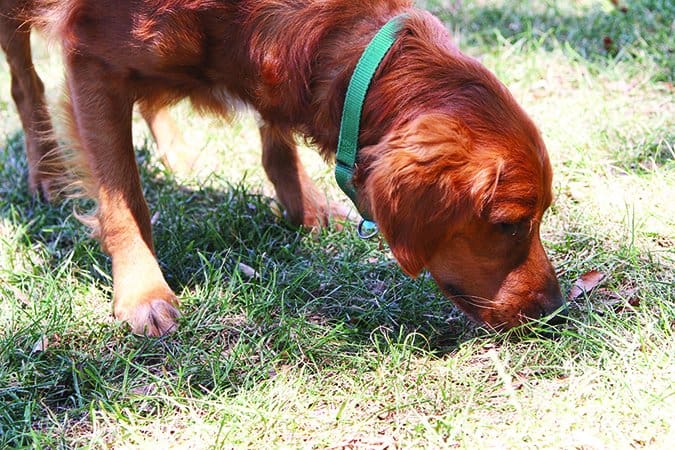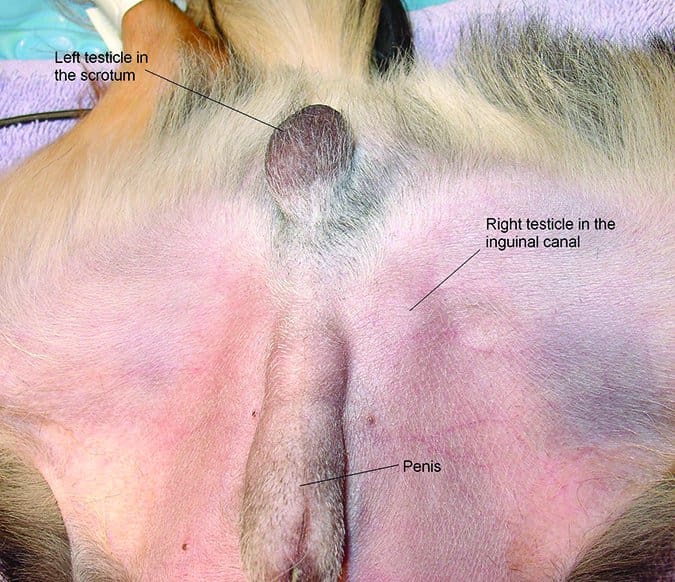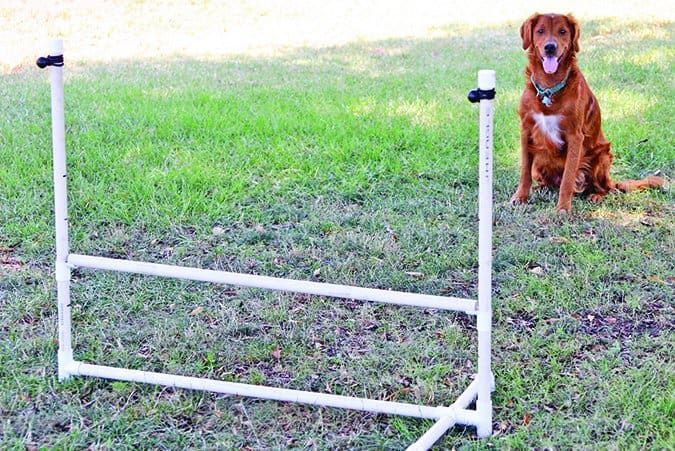If dogs hung out in locker rooms, swapping stories, I’m pretty sure my Golden Retriever, Saber, would take every opportunity to impress his pals with this gem: “Ya know, when I was younger, my testicles were such a big deal, I had to be neutered TWICE!” The best part? Saber’s story is completely true!

When I adopted Saber as a 2-year-old, I was told he was neutered, and he certainly appeared to lack testicles. However, a thorough review of his medical records, obtained from his previous owner, revealed that Saber had undergone neutering surgery, but only one testicle was found and removed; he still possessed a single, “hidden” testicle!
Cryptorchidism in Dogs
Cryptorchidism (from the Greek crypto, meaning hidden, and orkhis or orchid, meaning testicles) is the medical term for the condition that occurs when one or both testicles of a male dog fail to descend into the scrotum. It’s not an extremely common condition; various sources offer an incidence of between less than 1 percent and 10 percent.
It’s also variable as to whether it affects one testicle or two. When one testicle fails to drop, the condition is described as unilateral cryptorchidism; if neither descends, the dog has bilateral cryptorchidism. Many people mistakenly refer to unilateral cryptorchidism (which is more common) as being monorchid, which is incorrect. Monorchidism refers to the complete absence of a second testicle – only one ever developed – and it’s so rare, we’ve yet to find a vet who has ever seen a monorchid dog!
“There’s always a second testicle,” says Suzi Milder, DVM, of Chatsworth Veterinary Center in Chatsworth, California. It may be difficult to locate, but if the dog is being neutered, Dr. Milder says, “It’s the responsibility of veterinarians to find it and remove it.” Sometimes, this is quite a challenge, as was the case with Saber. The veterinarian who performed his first neuter surgery tried, but failed to find Saber’s second testicle. Fortunately, this was noted in Saber’s medical records, which I received from his previous owner a month or so after I adopted him.
I was lucky to learn about Saber’s condition; had he been a previously stray dog without medical records, I wouldn’t have known that I needed to schedule a second surgery to complete Saber’s neutering. (I’ll explain why I went to the considerable trouble to do so in a minute.)
How Dog Testicles Develop
How does it happen that testicular descent fails to occur in some cases? As the canine fetus develops, the testicles are formed in the abdomen, near the kidneys. Usually, as the puppy grows – initially, in utero, and then, after his birth – his testicles are gradually pulled from the abdomen, through the inguinal canal (a passageway through the abdominal wall), and into the scrotum by the gubernaculum, a ligamentous cord connecting the testes to the scrotum. Typically, the testes pass through the inguinal canal within a week or two after birth, and reach their final scrotal position by 6 to 8 weeks of age.
However, in some cases, the gubernaculum isn’t formed properly, or doesn’t function properly, and the testicle stays in the abdomen, Dr. Milder explains. “It can be anywhere – up by the kidney, in the canal along the pathway, or even in the subcutaneous tissue next to the scrotum.”
The right testicle is retained more often than the left, due to its more forward-starting position in the abdomen. Retained testicles are smaller than scrotal testicles, and abdominally retained testicles are smaller than inguinally retained testicles.
Dr. Milder says it’s even possible to have a late bloomer, where one or both testicles don’t reach the scrotum until up to six months old. If a testicle hasn’t “dropped” into the scrotum by six months of age, Dr. Milder and many of her colleagues say, it most likely won’t.
Cryptorchidism is genetic; it’s caused by an autosomal recessive gene that can be inherited by offspring. Research shows several breeds commonly known to be affected, including Standard Poodles, Boxers, German Shepherds, Weimaraners, English Bulldogs, Shetland Sheepdogs, and many of the toy breeds, such as Chihuahuas, Miniature Dachshunds, Pomeranians, Miniature Poodles, Maltese, and Yorkshire Terriers.
“There’s definitely a higher prevalence of cryptorchidism in small and toy-breed dogs,” confirms Brooke Neece, DVM, of Columbus, Ohio. “In larger dogs, there is a higher prevalence in the brachycephalic breeds such as Boxers and English Bulldogs.”

© Joel Mills
Problems Associated with Cryptorchidism in Dogs
Poor Saber. As if one neuter surgery wasn’t enough, when I learned he had a retained testicle, I planned a second surgery. Why go to all that trouble? Because cryptorchidism carries significant health risks.
Most seriously, dogs with cryptorchidism can develop torsion, an extremely painful condition where the testicle twists upon itself, inhibiting blood flow. The testicle swells as it becomes engorged with blood. This condition typically presents with abdominal pain and evidence of a firm mass in the stomach. The pain can be so severe it causes the dog to go into shock. Immediate removal of the testicle is required to provide relief.

used through Wikimedia Commons
Dogs with cryptorchidism are also at a higher risk of developing testicular cancer later in life. According to a fact sheet provided by the William R. Pritchard Veterinary Medical Teaching Hospital at the University of California, Davis, testicular cancer is the second most common cancer in older male dogs, and the risk among dogs with cryptorchidism increases by about 13 percent. While the incidence of testicular cancer is fairly low in the United States, due to the prevalence of neutering, an Italian study of 232 dogs (post-mortem) showed 27 percent had one or more testicular tumors.
The most common testicular tumors are Sertoli cell tumors, interstitial cell tumors, and seminomas. According to Daniel Denger, DVM, a board-certified veterinary surgeon with Animal Surgical Center in Flint, Michigan, metastasis occurs in about 10 to 20 percent of testicular tumors.
However, even when metastasis has not occurred, Milder says certain tumors can cause plenty of other problems, from mild to life-threatening. For example, Sertoli tumors produce estrogen and similar hormones, which can cause skin and coat problems, and even wipe out a dog’s bone marrow. While removal of the testicle or testicles is often curative, as with many things, an ounce of prevention can be worth a pound of cure.
“In my head, whether the tumor is malignant or benign, it would be much easier to perform major abdominal surgery to remove a retained testicle on a healthy, younger dog, than on a dog who is experiencing health problems because of a tumor,” Dr. Milder says. “Waiting can make things a lot more complicated and risky for the patient. It’s not a good answer to say, ‘I’ll wait until he’s sick,’ because then you’re adding a whole new layer of complications.”
Dogs with cryptorchidism typically display the same hormonally driven behaviors as dogs with descended testicles. They are often especially interested in intact females, and are capable of impregnating them in some cases. (When testicles remain in the body cavity, the increased temperature negatively impacts sperm viability. Dogs with bilateral cryptorchidism are almost always sterile or infertile, but some dogs who are unilaterally cryptorchid may have viable sperm.) In cases when a dog’s neutering history is unknown – even when the dog appears outwardly neutered – and the dog exhibits the libido or other hormonally driven behaviors typical of intact male dogs, the possibility of a remaining, retained testicle should be considered.
Finding the Dog’s Retained Testicle
While most vets feel six months is the age of “last call” for testicular descent, some make a case for watching and waiting much longer. “Classically, by the time a dog reaches six months of age, if he does not have two scrotal testicles, he is considered a cryptorchid . . . but, realistically, with the vast differences in age at puberty between breeds, this is probably not a reasonable expectation,” says Cheryl Lopate, DVM, of Reproductive Revolutions in Aurora, Oregon, a diplomate of the American College of Theriogenologists.
“Based on the average age of puberty for any given breed, one would expect to have both testes in the scrotum within two months of attaining puberty to be considered normal. This means that for large and giant breed dogs, testicular descent may not be complete until well over a year of age. Small- and medium-breed dogs should still be considered cryptorchid if two testes are not in the scrotum by six to eight months of age,” Dr. Lopate says.
In recent decades, veterinarians have typically recommended that male dogs who are not going to be used in a breeding program are neutered around six months of age; this recommendation stems from a desire to prevent unwanted reproduction (population control). But because the condition can be passed down to a dog’s offspring, most veterinarians recommend that even purebred dogs with cryptorchidism who were otherwise destined for a breeding career to be neutered. This is partly due to the fact that research suggests dogs with cryptorchidism are more likely to have other congenital problems as well.
“Because we would like to, ideally, eliminate this negative trait, I recommend neutering between six to 12 months so there’s not a chance of an accidental breeding where it’s passed on,” Dr. Milder says. “From a responsibility standpoint, the best thing to do is neuter sooner rather than later.”
However, when owners are confident they can prevent accidental breeding, and when they wish to maximize potential health benefits associated with neutering at a slightly older age, some vets are comfortable waiting until as late as four or five years old.
Finding an undescended testicle can be tricky, as it can go off-course at any point along its intended path. Dr. Neece says testicles in the inguinal (groin) area can often be felt with careful palpation. They typically can’t be felt in heavier dogs, nor can they be felt when in the abdomen. An ultrasound by a highly skilled technician will sometimes reveal the location, but is not always successful, since retained testis can be tucked away behind other anatomy.
When the retained testicle’s location is known, surgical removal is similar to spaying a female, in that an incision is made in the abdomen. If the location is unknown, surgery is exploratory. Some veterinarians, including Dr. Neece, prefer to start near the bladder, by the inguinal ring. “In my experience, I have found more abdominally retained testicles further down in the abdomen,” she says. If a retained testicle cannot be found in the vicinity of the bladder, a second incision is made higher in the abdomen, closer to the kidneys, where the testicles begin their development.
Beyond the typical risks associated with any surgical event, Dr. Neece says the most likely complications associated with neutering a dog with cryptorchidism are bruising and seromas (swelling caused by temporary fluid build-up at the surgical site). “You often have to dig around a little, in a small area, to find the testicle,” she says.
Re-Neutering a Dog With Cryptorchidism Is Worth It
Nobody like subjecting her dog to surgery – especially for a second time, as was the case with my dog! And there’s always the occasional piece of anecdotal evidence suggesting that dogs with cryptorchidism can live to a ripe old age without surgical intervention or complications. For me, however, the combination of my vet’s recommendation to re-neuter Saber by age four, the gnawing fear of cancer, and some unwanted, hormonally driven behavior (insatiable sniffing), solidified my decision to pursue the second surgery – which was successful. (And, I’m pleased to report the excess sniffing stopped almost immediately; I wouldn’t have believed it could happen so quickly, had I not witnessed the remarkable change.)
“It’s important for dog owners to understand that cryptorchidism is a real and potentially serious issue,” Dr. Neece says. “These dogs should absolutely not be used as breeding dogs. When dealt with at a young age (or, we would add, at an age deemed appropriate for your situation, by your vet), the prognosis is great and there aren’t any long-term effects of cryptorchidism.”
Dr. Milder agrees. “I’ve seen what can happen when cryptorchidism is untreated (torsion, tumors). It’s tragic and so preventable. One time is too many for me,” she says.







My 12 year old toy type b, tuxedo, rat terrier, Remington, has had an undecended right testicle, his whole life, obviously. Be now has a large swollen one, in his abdomen. I never got him neutered because it can cost up to 800.00, and I do not have a credit card, or enough money to get it done. I am scared be has cancer. I cannot do care credit, because I do not have good enough credit. My husband does not care. Our money is separate
I do not know what to do. I have done GoFundMe campaign’s before, for my female dog when she got pyometra. I am scared to do another gfm, because people will chastise me for not having the money to take care of Medical costs for my 5 rat terriers, I love so very much.
Sending prayers! How is your fur baby doing?
Ps I have something similar but no swelling or visible signs there is a issue 🙁 other then only one testie in the scrotom. Did your fur baby have any signs and where before swelling started?
So sorry about your fur kid Donna, I pray you have found help by now! There are rescue groups out there who sometimes can help with cost.
Donna, i hope u get the help u need for ur Remington, i am in a very similar situation with my Chihuahua/Shepherd mix Lilbaby. i was just curious if Remington has shown any symptoms other than the mass. My Lilbaby is bilateral Cryptorchid he’s just 18 months but i can’t afford surgery so i am worried everyday that he’s suffering.
Hey I have a question my dogs was mating with a female dog and some how his whole balls come out of the scrotum and ima really worried
I have the same problem with my dog right now. They opened him up but couldn’t find the undescended testicule in his abdomen. I am curious to know where did they find the testicule during the second surgery in your dog?
Did your dog have the other surgery my dog has just had the first surgery and they cudnt find it so worried thank u
My dog has had exploratory surgery, ultrasound, and recently lab work to try to find the undescended testicle (if there is indeed one). I keep hearing how uncommon it is for them to not have an actual testicle hiding in the abdominal area, but what other ways are there to find it?
My yorkie is 7. He doesnt have any issues so far but we have still decided to remove his right Cryptorchid testicle. The Vet advises to remove also the healthy one. I cand find online why we should remove both besides for him bot to breed. Can ypu point me towards some decent explanation , please!?
Thank you
Hi Andrea,
I have the same dilemma with my 4 year old cocker. He is perfect and well trained and I would not consider neutering other than to remove the retained testicle. I do not want to have the descended testicle removed at the risk of adverse affects associated with neutering. ….Please advise if you managed to get an explanation why most vets favour removing both testicles.